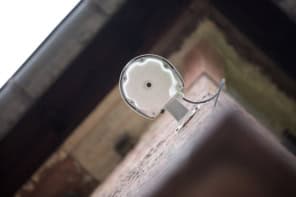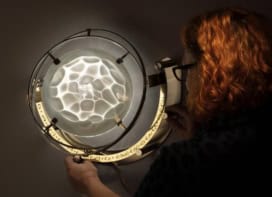In the classic 1991 film Terminator 2 Arnold Schwarzenegger’s robot assassin, the T-800, comes up against a next-generation model: the T-1000 Advanced Prototype. It is made from a liquid metal called “mimetic polyalloy”, which allows it to reform into any shape.
The T-1000 is able to slip through narrow openings by oozing into its fully liquid form, as well as reforming itself without suffering physical damage.
Now researchers in China and the US have come close to recreating in the lab some of the T-1000’s special abilities. They have designed miniature robots that can rapidly and reversibly shift between liquid and solid.
They did this by embedding magnetic particles in gallium, a soft metal with a low melting point. Applying an alternating magnetic field not only heats the magnetic particles, making the body become a liquid, but also allows it to become mobile.
In one video released by the team, a 10 mm-tall LEGO-like minifigure liquifies to ooze before passing through bars in a mock-up prison cell. It then cools inside a mould and the figure forms back into its original shape.
The authors think that the technique could have medical uses such as removing foreign objects from inside the body or to deliver drugs in hard-to-reach places. Let’s hope it doesn’t stretch to morphing killer robots.
Chaotic jewellery
From the weather to brain dynamics and even infant cries, chaos is everywhere. Now researchers at the Univeristy of Calabria in Italy have created jewellery using the fractal structure that results from chaos.
The intricate, twisting shapes are based on the Chua circuit — an electronic system that was invented in 1983 and is thought to be one of the first proofs of chaos. An ordinary circuit produces an oscillating current, but Chua’s circuit results in oscillations that never repeat. Computer simulations of the circuit display chaotic shapes called “strange attractors”.
The team got in touch with goldsmiths to recreate the attractor patterns but it proved too tricky using traditional techniques. They then turned to 3D printing to create a mould that was then used by the goldsmiths to successfully create the designs.
The team now plan an exhibition based on chaos that can be adapted for international museums and say that the jewellery could be used for educational purposes.
“Jewellery seemed the best way to interpret the beauty of chaotic shapes,” notes Eleonora Bilotta. “Touching and wearing them was also extremely exciting”.
Heat sink
And finally, 22 January marked Chinese New Year where the year of the tiger made way for the year of the rabbit.
During the week-long celebration, work is suspended, businesses close and nearly three billion people leave the city to join their families in rural areas. According to a new study, the holiday is not only the largest short-term suspension of human activity on Earth but is also associated with lower temperatures in major Chinese cities too.
The study found that the urban heat island intensity – the difference in temperature between urban areas and their rural surroundings — dropped by 33% on average in 31 Chinese cities. This corresponded to an average drop in surface air temperature of 0.35 degrees Celsius. Chilly.



